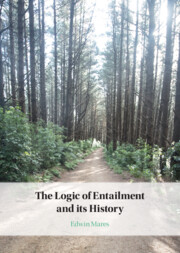Book contents
- Frontmatter
- Dedication
- Contents
- Preface
- Acknowledgements
- Table of Symbols
- 1 Why Entailment?
- Part I Entailment in the Twentieth Century
- 2 C. I. Lewis and His School
- 3 Entailment and Possible Worlds
- 4 Entailment and Relevance
- 5 Reflexivity
- Part II Theories and Entailment
- 6 Theories and Closure
- 7 Theories of Entailment
- Part III The Logic E of Relevant Entailment
- 8 The Logic of Entailment
- 9 Negation and Disjunction
- 10 Quantification
- 11 Entailment and Reasoning
- Appendix Systems, Semantics, and Technical Results
- References
- Index
11 - Entailment and Reasoning
Published online by Cambridge University Press: 08 February 2024
- Frontmatter
- Dedication
- Contents
- Preface
- Acknowledgements
- Table of Symbols
- 1 Why Entailment?
- Part I Entailment in the Twentieth Century
- 2 C. I. Lewis and His School
- 3 Entailment and Possible Worlds
- 4 Entailment and Relevance
- 5 Reflexivity
- Part II Theories and Entailment
- 6 Theories and Closure
- 7 Theories of Entailment
- Part III The Logic E of Relevant Entailment
- 8 The Logic of Entailment
- 9 Negation and Disjunction
- 10 Quantification
- 11 Entailment and Reasoning
- Appendix Systems, Semantics, and Technical Results
- References
- Index
Summary
This chapter discusses the application of the logic to actual theories. In particular, it discusses the use of this relevant logic to make inferences about classical theories. It also examines the internal structure of theories and the nature of the conditionals in those theories. At the end of the chapter, some suggestions are made about generalizing the semantical theory of the book to treat the application of background scientific theories to other theories and some consequences for scientific confirmation.
Keywords
Information
- Type
- Chapter
- Information
- The Logic of Entailment and its History , pp. 215 - 227Publisher: Cambridge University PressPrint publication year: 2024
